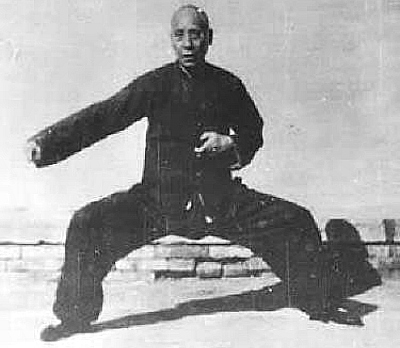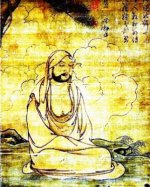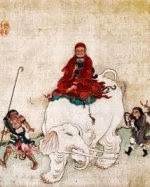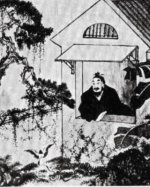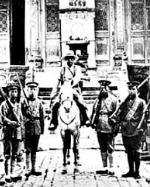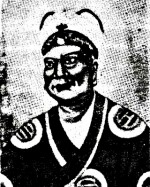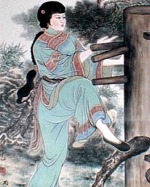The History of Tai Chi Chuan
Talk the Talk
Tai Chi Chuan, also known as Taijiquan, Shadow Boxing and often shortened to Tai Chi, can be translated to mean Supreme Ultimate Fist.
The term Tai Chi first appeared as a philosophical term in the Book of Changes over three thousand years ago during the Zhou Dynasty (1100-1221 BCE). The book states:
“In all changes exists Tai Chi, which causes the two opposites in everything”. ! In this context, the Supreme Ultimate is often used to describe the vastness of
the universe".
Walk the Walk
Tai Chi Chuan is a style of internal Chinese martial arts based on Taoist philosophical principles.
Ying and Yang, which stresses the natural balance in
all things and that everything in life is a series of dualities, is an important part of the teachings as is the concept of living in spiritual and physical harmony with the
natural world.
Kung Fu Legends
When Chen Fake was a child, he was lazy and though he was often sick, would rarely practice Tai Chi.
This was a disappointment to his father who was
highly skilled in the art so as he grew older, Fake decided he would improve.
He often practised with his cousin who was way ahead of him in skill as he had practised diligently for much longer.
One day, while they were out walking, his cousin realised he had left something behind so told Fake to run back and fetch it while he walked on slowly.
He did as he was told and as he caught up with his cousin he realised that if he ever wanted to catch his cousin’s skill level in the martial arts, he would have to train
harder and for longer hours, which he did from that day on.
Before long, he had improved enough that he began to beat his cousin when they spared and over the coming years he
continued to improve, eventually becoming one of the most famous masters of Tai Chi Chuan the world has ever seen.
 There are two main schools of thought on who founded Tai Chi Chuan. Some claim it was Zhang Sanfeng, a Taoist priest from the Ming Dynasty (1368 - 1644) who developed it in the Wu-Tang Mountains. Others maintain however that this is just a legend and the Chinese martial arts style was in fact created by Chen Wangting (pictured right), around the mid-seventeenth century.
There are two main schools of thought on who founded Tai Chi Chuan. Some claim it was Zhang Sanfeng, a Taoist priest from the Ming Dynasty (1368 - 1644) who developed it in the Wu-Tang Mountains. Others maintain however that this is just a legend and the Chinese martial arts style was in fact created by Chen Wangting (pictured right), around the mid-seventeenth century. There are many styles of Tai Chi Chuan practised today, however, most can trace their roots back to one or more of five traditional schools. They are; Chen, Yang, Wu/Hao, Wu and Sun. They all differ in various ways including the speed they perform the movements, how they transition from postures and the level of power they employ.
Basic Aspects of Tai Chi Chuan
Utilising Chi (also known as Qi) is a key aspect of the study. Not to be confused with the ‘Chi’ in the name of the art, it is believed to be an eternal energy force that flows through all of us. Many of the movements, breathing exercises and meditations practised are designed to aid the flow of Chi which helps the practitioner to relax, to maintain a general feeling of well-being and is believed to promote overall good health.
A practitioner of Tai Chi learns various forms that are a set sequence of movements much like the kata of Japanese martial arts like karate. The more basic ones have fewer movements, as few as four, whereas the more advanced ones can have over one hundred postures and take up to twenty minutes to perform. As well as the more traditional ones, there are modern forms, competition forms and even weapon forms which utilise the use of swords, fans and other common kung fu weapons.
The three main components of Tai Chi are known as the Three Treasures, they are;
Jing - This is the body's physical essence and is concerned with the movements of Tai Chi. All the major muscle groups are used when practicing forms and exercises meaning it can help develop strength, muscle tone and strengthen the bones. As the movements tend to be practised at a slow pace, it is suitable for people of all ages and also improves balance, agility, flexibility and stamina.
Shen - This is the silent mental focus gained through meditation which has numerous benefits including an overall feeling of well-being after being performed. It can also help improve concentration, help with relaxation, decrease stress and has been shown to lower the heart rate and blood pressure.
Chi - This is the life energy that flows through everybody. Deep breathing exercises are very important to help the Chi flow as they release stale air and toxins from the body. They also help increase lung capacity, aid relaxation, lower stress and raise mental awareness by helping blood circulation to the brain.
Chen Tai Chi
Chen Tai Chi is believed by many to be the foundation of Tai Chi Chuan and was created by Chen Wangting, a Royal Guard of the Chen village in the Henan Province who began studying Taoism after retiring from the army. The moves he developed were greatly influenced by a book called Boxing in Thirty-Two Forms by a renowned general called Qi Jiguang.
He also studied and applied Daoyin, the concentrated exertion of the inner force and included in his art a set of deep breathing exercises called Tuna, which would evolve into the Qigong exercises that are an integral part of Tai Chi today. Chen Tai Chi has an emphasis on coiling movements and practitioners move between postures quickly with an explosive release of power. It uses low stances and is rich with combative moves making it particularly suited for younger men and women who want to learn martial arts.
After its development, Chen-style kung fu was kept a secret, only being taught within the Chen village to the extent that while some would teach it to their daughters-in-law, they would not teach it to their daughters as they would tend to leave the village if they married outside of it. This secrecy continued right up to the twentieth century when Chen Fake (pictured below) began to teach outside the village to spread the art of Tai Chi Chuan.
Yang Tai Chi
The Yang style was developed by Yang Lu-Chan (1799-1872), who learned the art from the Chen village and then modified it. As a young man, he was a practitioner of kung fu who trained with several masters until one day he sparred with a Tai Chi expert, who easily got the better of him. He was fascinated by the style and eager to learn but as he wasn’t from the Chen village, he knew this would be difficult.
Yang hatched a plan and dressing like a beggar, he went to the Chen village. Feigning starvation he made his way to the door of Chen Changxing (1771-1853), the fourteenth-generation Chen patriarch and when he got there he pretended to pass out. He was taken in and accepted as a servant in the Chen household and while there, he would watch the practice of Tai Chi through a crack in the wall, and then practice the moves whenever he had the chance.
One day he was discovered and as he had ‘stolen’ this knowledge, he could have been legally executed. However, Changxing was so impressed with his skill that he forgave his crime and accepted him as a student. When he eventually left the village, he developed his own version of the art and travelled to China to teach Yang Tai Chi.
He quickly gained a reputation for himself, becoming known by many as Yang the Invincible.
Over time he introduced higher stances and emphasised slower, gentler movements that tend to move at an even pace, flowing from one posture to another. Yang Tai Chi is, therefore, more accessible for people with health problems and older people, and is probably the most popular style practised around the world today.
Hao Tai Chi
Hao (also known as Wu style) places great emphasis on internal force and correct technique. The moves are generally practised slowly and have the appearance of being large and well-rounded. It was created by Wu Yuxiang (1812-1880) and passed on to Hao Weizheng (1849-1920) who made significant developments to the style. Both had in-depth knowledge of Chan and Yang Tai Chi and blended their knowledge to create and develop the Hao style.
Wu Tai Chi
Wu Style, not to be confused with the Hao/Wu style mentioned above, emphasises softness and the redirection of incoming force. It was created by Wu Quan-You (1834-1902) and later developed by his son Wu Jian-Quan (1870-1942). It has many hand techniques and is characterised by a posture in which the practitioner is slightly leaning forward.
Sun Tai Chi
Sun style uses agile steps so that when one foot moves, the other follows it. The stances are high and the movements flow smoothly, with a powerful Qigong exercise utilised whenever a change of direction is required. It was created by Sun Lu-Tang (1861-1932) and is the youngest of the five major styles.
In 1912, Sun, already prolific in the internal martial arts of Xingyiquan and Baguaquan, met Hao Weizheng without realising who he was. Hao was taken ill so Sun took care of him by finding him a place to stay and getting a doctor to examine him. After his recovery, Hao agreed to teach Hao Tai Chi to Sun who blended the art with the knowledge he already had on internal martial arts to create the Sun style.
Modern Tai Chi
Tai Chi Chuan has long been a hugely popular pass time in China practiced by tens of thousands of people across the country. Today, Tai Chi has become a widespread world martial art and exercise system practised in dozens of countries with millions of devotees. Part of its appeal is its versatility as it can be used by people of all ages, from all walks of life and even by people with health problems.
Many practice the art purely as a method of exercise and gain numerous health benefits from doing so. For those who want to learn martial arts, the same moves can be used with fighting applications in mind so that self-defence is added to a myriad of benefits that can be gained from the regular practice of Tai Chi Chuan.
Written by Andrew Griffiths – Last updated 11/10/2023. If you like
what you see, consider following the History of Fighting on social media.
Further Reading:
Clear, S. [Internet]. 2010. The Difference Between Healthy Tai Chi & Fighting Tai Chi. Clear's Tai Chi. Available From:
http://www.clearstaichi.com/tai-chi-health/the-difference-between-healthy-tai-chi-fighting-tai-chi-1793.html [Accessed Oct 2, 2019].
Dr Lam, P. [Internet]. 2007. History of Tai Chi. Tai Chi for Health Institute. Available From:
https://taichiforhealthinstitute.org/history-of-tai-chi-2 [Accessed Oct 2, 2019].
History of Tai Chi. [Internet]. 2011. The Telegraph. Available From: http://www.telegraph.co.uk/news/health/news/8517475/History-of-Tai-Chi.html
[Accessed Oct 2, 2019].
Morrisey, J. [Internet]. 2013. History and Globalization of Tai Chi Chuan. William and Mary University. Available From:
http://chinese.blogs.wm.edu/2013/04/16/history-and-globalization-of-tai-chi-chuan [Accessed Oct 2, 2019].
Tai Chi Background. [Internet]. 2012. The City University of New York. Available From:
https://macaulay.cuny.edu/eportfolios/rosenberg12/tai-chi-background [Accessed Oct 2, 2019].
Wai Yi, W. [Internet]. 2019. History of Taiji. American Chen Taiji Society. Available From:
http://chenfamilytaiji.com/taiji_history.html [Accessed Oct 2, 2019].
More Kung Fu History
Kung Fu History Home
Kung fu history arguably goes back to the 6th century CE and the term kung fu can be used to describe any Chinese martial art. Though there are many styles, philosophies and techniques, most trace their ancestry to the Shaolin Monastery in Henan which has been instrumental in the development and spread of many fighting systems down the ages, collectively known in the West as kung fu.
Kung fu history arguably goes back to the 6th century CE and the term kung fu can be used to describe any Chinese martial art. Though there are many styles, philosophies and techniques, most trace their ancestry to the Shaolin Monastery in Henan which has been instrumental in the development and spread of many fighting systems down the ages, collectively known in the West as kung fu.
Bodhidharma
Bodhidharma (Ta Mo in Chinese) was an Indian Buddhist monk who is believed to have travelled to China in the sixth century. So the legend goes, while there he visited the Shaolin Monastery and taught the monks there a set of yogic exercises to improve their overall health. Over time, these exercises would evolve into martial arts, or more specifically, into Shaolin kung fu.
Bodhidharma (Ta Mo in Chinese) was an Indian Buddhist monk who is believed to have travelled to China in the sixth century. So the legend goes, while there he visited the Shaolin Monastery and taught the monks there a set of yogic exercises to improve their overall health. Over time, these exercises would evolve into martial arts, or more specifically, into Shaolin kung fu.
The Early History of Shaolin Kung Fu
A look at how the the history of Shaolin Kung Fu expanded and grew between 527 and 1644. It is believed that many styles of Chinese martial arts have their origins in this period, which also saw the spread of the teachings of the Shaolin monks to temples in other regions.
A look at how the the history of Shaolin Kung Fu expanded and grew between 527 and 1644. It is believed that many styles of Chinese martial arts have their origins in this period, which also saw the spread of the teachings of the Shaolin monks to temples in other regions.
Zhang Sanfeng
Zhang Sanfeng who, according to legend, was the founder of an internal Chinese martial art known as Mien Chuen that would evolve into Tai Chi Chuan. After spending many years training in the Shaolin Temple, he made his way to the Wu Tang Mountains where he developed his new style after watching a fight between a snake and a crane.
Zhang Sanfeng who, according to legend, was the founder of an internal Chinese martial art known as Mien Chuen that would evolve into Tai Chi Chuan. After spending many years training in the Shaolin Temple, he made his way to the Wu Tang Mountains where he developed his new style after watching a fight between a snake and a crane.
The Shaolin in the Modern Era
The history of the Shaolin in the modern era has not been an easy one. The practice of Chinese martial arts was banned for much of the period and the monks considered enemies of the state because of their political ideologies and later their religious beliefs.
The history of the Shaolin in the modern era has not been an easy one. The practice of Chinese martial arts was banned for much of the period and the monks considered enemies of the state because of their political ideologies and later their religious beliefs.
Pak Mei – A Kung Fu Legend
Pak Mei was one of the famous Five Elders of Shaolin kung fu who developed the fighting system that would take his name. The system is a lethal combination of fighting techniques that combine the explosive power of the tiger with the dynamic speed of the leopard.
Pak Mei was one of the famous Five Elders of Shaolin kung fu who developed the fighting system that would take his name. The system is a lethal combination of fighting techniques that combine the explosive power of the tiger with the dynamic speed of the leopard.
Wing Chun Kung Fu
According to legend, after the burning of the Shaolin Temple in the 17th century one of the surviving Five Elders, Ng Mui, taught kung fu to a woman called Yim Ving Tsun. From this union, Ving Tsun (Wing Chun) kung fu was developed and passed down from one generation to the next.
According to legend, after the burning of the Shaolin Temple in the 17th century one of the surviving Five Elders, Ng Mui, taught kung fu to a woman called Yim Ving Tsun. From this union, Ving Tsun (Wing Chun) kung fu was developed and passed down from one generation to the next.
The images on this site are believed to be in the public domain, however, if any mistakes have been made and your copyright or intellectual rights have been breeched, please contact andrew@articlesonhistory.com.

